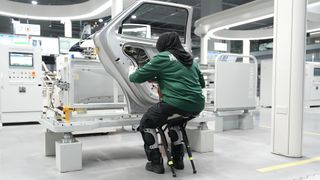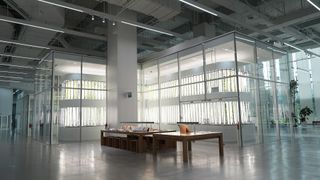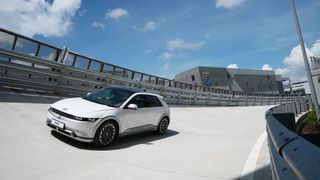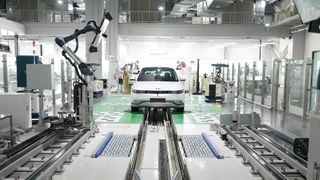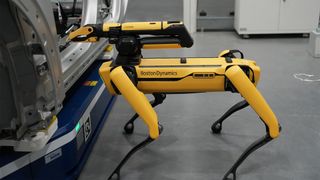Inside Hyundai’s new sci-fi smart factory – where you can order a car with your smartphone and drive it away in hours
The process of buying a car has been largely unchanged for decades, but Hyundai’s new AI-powered smart factory is giving it a timely makeover – and I just walked in to see the incredible future of personalized electric vehicles .
The Hyundai Motor Group Innovation Center Singapore (HMGICS for short) isn’t just a firmware update to the traditional assembly line – it’s a futuristic (and somewhat terrifying) look at our increasingly robotic, AI-driven future.
While Boston Dynamics’ Spot robot roams around approving vehicles, a fully digital twin on the factory floor runs simulations that show how the space can be better optimized. But perhaps the most interesting thing is that you can order a new car from the Hyundai factory and drive it away the same day. Welcome to the factory of the future…
Eeriely quiet
From the moment you step into the Hyundai Motor Group Innovation Center Singapore (HMGICS for short), it is clear that it is like no other mass production car factory.
Firstly, it is eerily quiet, the walls, ceilings and floor are white of the science laboratory and there is a robot carefully tending a variety of lettuce leaves in the vertical farm that takes pride of place in the entrance hall.
People are supported by – and sometimes report to – robots. Lots of robots.
The facility, which Hyundai wants you to call a “smart urban mobility hub,” is the South Korean company’s idea of a forward-looking smart factory that relies heavily on computing power, AI and robotics to quickly respond to the changing needs of the customer. and production requirements.
HMGICS is spread over seven floors, similar to Fiat’s old Lingotto factory, and nestled in the center of Singapore’s bustling start-up metropolis. It’s a far cry from the sprawling 200-hectare site (that’s more than 300 football fields) in Nošovice, Czech Republic. , which employs more than 3,000 employees and produces approximately 350,000 cars per year.
This explains why it’s so peacefully quiet inside, as Hyundai’s state-of-the-art factory currently employs just 29 employees on the “factory floor.” That number may seem bizarre, but at HMGICS people are supported by – and sometimes report to – robots. Lots and a lot of of robots.
Autonomous delivery units move quietly around the factory floor, operating the elevator and moving up and down the different levels to deliver parts to the small team of engineers working on vehicles in a cell-based production process.
“This is not like a traditional manufacturing factory,” explains VP and Head of Smart Factory Technology, Alpesh Patel. “We plan to produce around 70 cars per day here, so it’s not a mass production line, but that’s not the point. The speed at which we can respond to customer personalization demands and cater to bespoke project requirements is unparalleled,” he adds. .
The setup means that most HGMICS employees are highly qualified engineers, working in a single cell and wearing the latest generation of exoskeleton technology to support manual tasks.
Once the robots have done the bulk of the vehicle assembly, they perform more than 40 jobs on a single vehicle, rather than repeating just one thing as a chassis rolls along a production line.
Nothing to see here. Simply “bark” commands at Spot the robot dog at Hyundai’s state-of-the-art Innovation Center in Singapore. pic.twitter.com/LiGnP67aJnNovember 21, 2023
To combat potential quality control issues, Hyundai has enlisted the help of Boston Dynamics’ agile robot dog, Spot.
Here Spot will routinely leave the charging station to check the vehicle or project in question, using the power of advanced camera, sensor and AI technology to scan the vehicle for faults and then report any findings back to the employee and the Digital Command. Center that oversees the entire operation.
Only when Spot (and the command center) is satisfied with the finish can the mechanic continue working on the vehicle. Patel says it reduces to virtually nothing the quality control issues that typically occur at the end of the process.
How do you order?
While HMGICS is a fully operational factory, with the capacity to produce 30,000 EVs per year, including the Ioniq 5, Ioniq 6 and Ioniq 5-based robotaxis for autonomous driving partners Motional, it also serves as a flashy customer experience center.
Smart Factory boss Alpesh Patel spoke about the high degree of customization he envisioned in the offering to potential, affluent customers. “They can order a vehicle from home or here at the factory, choose their color and even select highly personalized elements for their car, and then witness it being brought to life,” he says.
Patel claims that it can take as little as three hours for a customer to order a vehicle and drive away, thanks to the unique design of the highly automated cell-based manufacturing process.
Once ready, customers can enjoy lettuce leaves from the in-house vertical farm and take their new vehicle for a test drive on the 620-foot Skytrack on the facility’s roof. The parallels with Fiat’s Lingotto factory remain.
But more than a way to wow customers, Patel says the facility will be an integral part of the design and construction of Purpose Built Vehicles (PBVs) in the future.
“We want to invite future mobility providers and enable them to realize their ideas. This facility allows us to be highly reactive and create vehicles for specific requirements, rather than just for the wishes of the individual,” he adds .
A digital twin
With around 50 percent of all tasks performed by around 200 robots, HGMICS predictably needs a serious amount of computing power to ensure everything runs smoothly. In this case it’s called a Digital Command Center and if you’re suddenly thinking of NASA space missions, you’re not far off.
Just a handful of highly skilled employees work with screen walls that can retrieve a wealth of smart factory data, monitor the efficiency levels of each production cell and predict when a robot needs maintenance or a part needs to be ordered long before it is needed. arises.
In a separate part of the room is a fully digital twin of the factory floor (a meta-factory, as it is called), which can run simulations as new production requirements arise. Patel claims that Digital Command Center staff are currently an integral part of the operation, but he argues that AI will soon take things a step further and provide the majority of day-to-day functionality.
Asked whether just one digital command center could remotely monitor multiple smart factories like this one, Patel said he didn’t see why not. “This is just the starting point. We have only been operational for a few weeks. Once the AI is up to speed, all staff there will be freed up to work on other software projects,” he said.
If you’re concerned about robotics and AI for your work, it’s probably best not to visit HMGICS. When questioned about the impact on lower-skilled workers, Patel acknowledged the problem and stated that the institution planned to improve the skill level of its employees. Although he reiterated that it would not replace a traditional production line.
But in reality, robots perform most of the tasks here, and Spot the Boston Dynamics dog is in charge.
The future factory
While not designed to replace today’s mass production lines (this highly robotic setup is simply too expensive), Hyundai’s Innovation Center will pave the way for a highly flexible manufacturing process that will help produce Purpose Built Vehicles and smart mobility solutions in the future.
During discussions, Joseph Hongbum Jung, Chief Executive Officer of HMGICS, stated that as cities like Singapore become increasingly congested, they need smarter transportation solutions to function effectively. He envisions Hyundai being part of that solution.
With that in mind, the team at HMGICS stated that the futuristic manufacturing plant would continue to adapt to changing demands, exemplifying that it will be an integral part of the production of eVTOL Urban Air Mobility vehicles.
Thanks to a partnership with Supernal, which already has an eVTOL concept vessel in testing, we could see advanced air mobility arriving as early as 2028.

